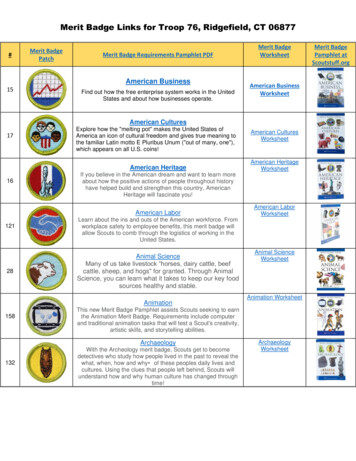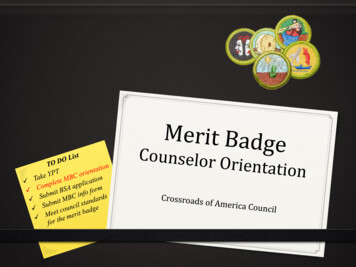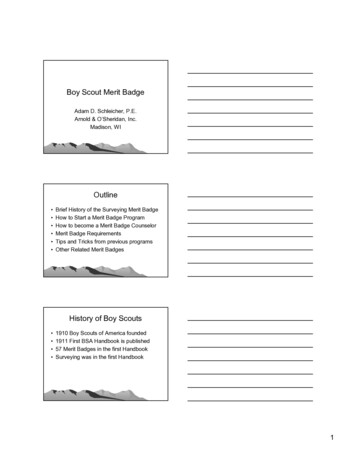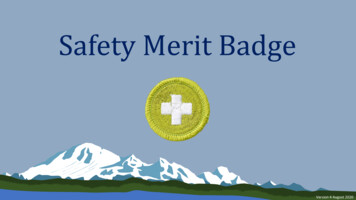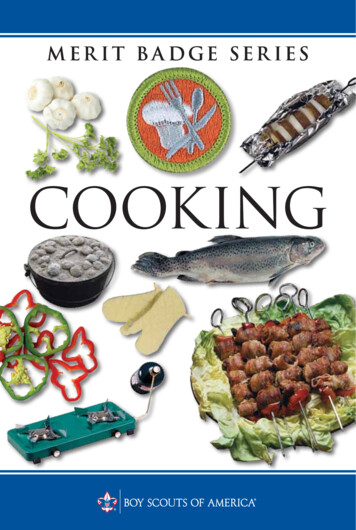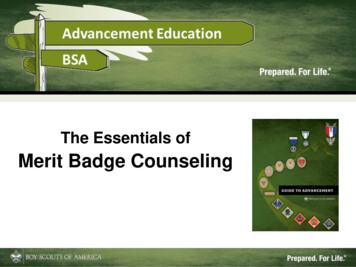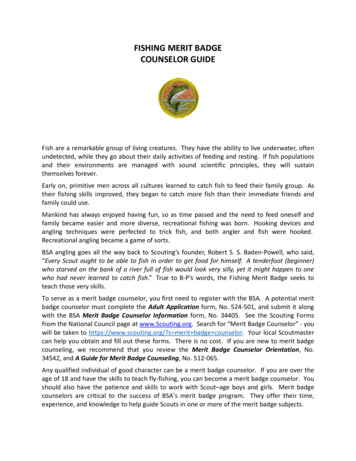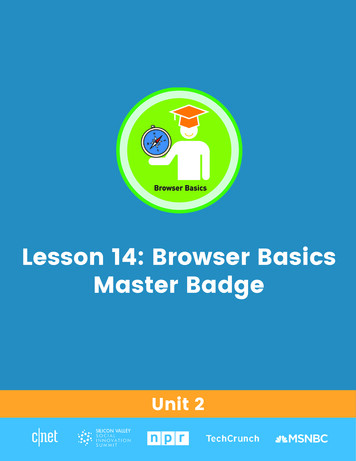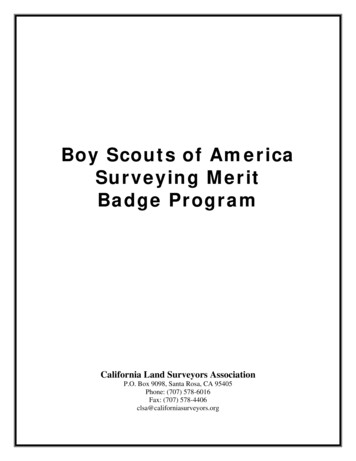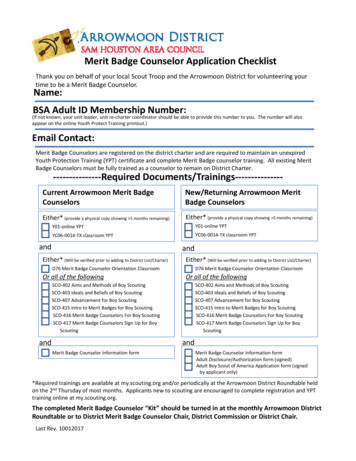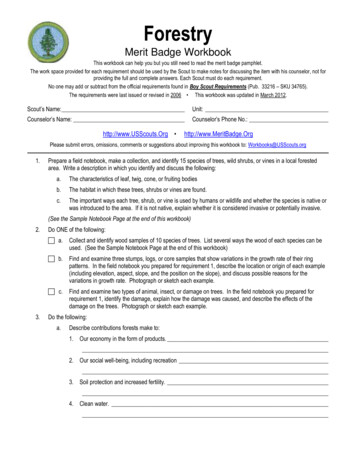
Transcription
ForestryMerit Badge WorkbookThis workbook can help you but you still need to read the merit badge pamphlet.The work space provided for each requirement should be used by the Scout to make notes for discussing the item with his counselor, not forproviding the full and complete answers. Each Scout must do each requirement.No one may add or subtract from the official requirements found in Boy Scout Requirements (Pub. 33216 – SKU 34765).The requirements were last issued or revised in 2006 This workbook was updated in March 2012.Scout’s Name:Unit:Counselor’s Name:Counselor’s Phone No.:http://www.USScouts.Org http://www.MeritBadge.OrgPlease submit errors, omissions, comments or suggestions about improving this workbook to: Workbooks@USScouts.org1.Prepare a field notebook, make a collection, and identify 15 species of trees, wild shrubs, or vines in a local forestedarea. Write a description in which you identify and discuss the following:a.The characteristics of leaf, twig, cone, or fruiting bodiesb.The habitat in which these trees, shrubs or vines are found.c.The important ways each tree, shrub, or vine is used by humans or wildlife and whether the species is native orwas introduced to the area. If it is not native, explain whether it is considered invasive or potentially invasive.(See the Sample Notebook Page at the end of this workbook)2.Do ONE of the following: a. Collect and identify wood samples of 10 species of trees. List several ways the wood of each species can beused. (See the Sample Notebook Page at the end of this workbook) b. Find and examine three stumps, logs, or core samples that show variations in the growth rate of their ringpatterns. In the field notebook you prepared for requirement 1, describe the location or origin of each example(including elevation, aspect, slope, and the position on the slope), and discuss possible reasons for thevariations in growth rate. Photograph or sketch each example. c. Find and examine two types of animal, insect, or damage on trees. In the field notebook you prepared forrequirement 1, identify the damage, explain how the damage was caused, and describe the effects of thedamage on the trees. Photograph or sketch each example.3.Do the following:a.Describe contributions forests make to:1. Our economy in the form of products.2. Our social well-being, including recreation3. Soil protection and increased fertility.4. Clean water.
ForestryScout's Name:5. Clean air. (carbon cycling, sequestration)6. Wildlife habitat7. Fisheries habitat8. Threatened and endangered species of plants and animalsb.Tell which watershed or other source your community relies on for its water supply.4.Describe what forest management means, including the following:a.Multiple-use managementb.Sustainable forest managementc.Even-aged and uneven-aged management and silvicultural systems associated with each type.d.Intermediate cuttings.e.The role of prescribed burning and related forest management practices.5.With your parent's and counselor's approval, do ONE of the following: a. Visit a managed public or private forest area with its manager or a forester familiar with it. Write a brief reportdescribing the type of forest, the management objectives, and the forestry techniques used to achieve theobjectives. b. Take a trip to a logging operation or wood-using industrial plant and write a brief report describing:1. The species and size of trees being harvested or used and the location of the harvest area ormanufacturer.2. The origin of the forest or stands of trees being utilized (e.g., planted or natural)3. The forest's successional stage. What is its future?4. Where the trees are coming from (land ownership) or where they are going (type of mill or processingplant)5. The products that are made from the trees6. How the products are made and used.Forestry - Merit Badge WorkbookPage. 2 of 10
ForestryScout's Name:7. How waste materials from the logging operation or manufacturing plant are disposed of or utilized.c.Take part in a forest-fire prevention campaign in cooperation with your local fire warden, state wildfire agency,forester, or counselor. Write a brief report describing the campaign, how it will help prevent wildfires, and yourpart in it.6.Do the following:a.Describe the consequences to forests that result from FIVE of the following elements: wildfire, absence of fire,insects, tree diseases, air pollution, overgrazing, deer or other wildlife overpopulation, improper harvest, andurbanization. Wildfire: Absence of fire: Insects: Tree diseases: Air pollution: Overgrazing: Deer or other wildlife overpopulation: Improper harvest: Urbanization:b.Explain what can be done to reduce the consequences you discussed in 6a.Forestry - Merit Badge WorkbookPage. 3 of 10
ForestryScout's Name:c.Describe what you should do if you discover a forest fire and how a professional firefighting crew might controlit.What to do:How a professional firefighting crew might control it.Name your state or local wildfire control agency. 7. Visit one or more local foresters and write a brief report about the person (or persons). Or, write about a forester'soccupation including the education, qualifications, career opportunities, and duties related to forestry.Requirement resources can be found stry#Requirement resourcesForestry - Merit Badge WorkbookPage. 4 of 10
ForestryScout's Name:Req. 1A-1D: Field Notebook Collection Identifying 15 Species of TreesAttach sample hereAttach sample /Invasive?Attach sample hereAttach sample /Invasive?Forestry - Merit Badge WorkbookPage. 5 of 10
ForestryScout's Name:Attach sample hereAttach sample /Invasive?Attach sample hereAttach sample /Invasive?Forestry - Merit Badge WorkbookPage. 6 of 10
ForestryScout's Name:Attach sample hereAttach sample /Invasive?Req. 2A: Field Notebook Collection Identifying 10 Wood SamplesAttach sample hereAttach sample hereSpecies:Species:Uses:Uses:Forestry - Merit Badge WorkbookPage. 7 of 10
ForestryScout's Name:Attach sample hereAttach sample hereSpecies:Species:Uses:Uses:Attach sample hereAttach sample hereSpecies:Species:Uses:Uses:Forestry - Merit Badge WorkbookPage. 8 of 10
ForestryScout's Name:Attach sample hereAttach sample hereSpecies:Species:Uses:Uses:Attach sample hereAttach sample hereSpecies:Species:Uses:Uses:Forestry - Merit Badge WorkbookPage. 9 of 10
Attachment – (NOTE: It is not necessary to print this page.)Important excerpts from the ‘Guide To Advancement’, No. 33088:Effective January 1, 2012, the ‘Guide to Advancement’ (which replaced the publication ‘Advancement Committee Policies and Procedures’) isnow the official Boy Scouts of America source on advancement policies and procedures. [ Inside front cover, and 5.0.1.4 ] — Unauthorized Changes to Advancement ProgramNo council, committee, district, unit, or individual has the authority to add to, or subtract from, advancement requirements.(There are limited exceptions relating only to youth members with disabilities. For details see section 10, “Advancement for MembersWith Special Needs”.) [ Inside front cover, and 7.0.1.1 ] — The ‘Guide to Safe Scouting’ AppliesPolicies and procedures outlined in the ‘Guide to Safe Scouting’, No. 34416, apply to all BSA activities, including those related toadvancement and Eagle Scout service projects. [Note: Always reference the online version, which is updated quarterly.] [ 7.0.3.1 ] — The Buddy System and Certifying CompletionYouth members must not meet one-on-one with adults. Sessions with counselors must take place where others can view theinteraction, or the Scout must have a buddy: a friend, parent, guardian, brother, sister, or other relative —or better yet, another Scoutworking on the same badge— along with him attending the session. When the Scout meets with the counselor, he should bring anyrequired projects. If these cannot be transported, he should present evidence, such as photographs or adult certification. His unitleader, for example, might state that a satisfactory bridge or tower has been built for the Pioneering merit badge, or that meals wereprepared for Cooking. If there are questions that requirements were met, a counselor may confirm with adults involved. Oncesatisfied, the counselor signs the blue card using the date upon which the Scout completed the requirements, or in the case ofpartials, initials the individual requirements passed. [ 7.0.3.2 ] — Group InstructionIt is acceptable—and sometimes desirable—for merit badges to be taught in group settings. This often occurs at camp and meritbadge midways or similar events. Interactive group discussions can support learning. The method can also be attractive to “guestexperts” assisting registered and approved counselors. Slide shows, skits, demonstrations, panels, and various other techniques canalso be employed, but as any teacher can attest, not everyone will learn all the material.There must be attention to each individual’s projects and his fulfillment of all requirements. We must know that every Scout —actually and personally— completed them. If, for example, a requirement uses words like “show,” “demonstrate,” or “discuss,” thenevery Scout must do that. It is unacceptable to award badges on the basis of sitting in classrooms watching demonstrations, orremaining silent during discussions. Because of the importance of individual attention in the merit badge plan, group instructionshould be limited to those scenarios where the benefits are compelling. [ 7.0.3.3 ] — Partial CompletionsScouts need not pass all requirements with one counselor. The Application for Merit Badge has a place to record what has beenfinished — a “partial.” In the center section on the reverse of the blue card, the counselor initials for each requirement passed. In thecase of a partial completion, he or she does not retain the counselor’s portion of the card. A subsequent counselor may choose notto accept partial work, but this should be rare. A Scout, if he believes he is being treated unfairly, may work with his Scoutmaster tofind another counselor. An example for the use of a signed partial would be to take it to camp as proof of prerequisites. Partials haveno expiration except the 18th birthday.Page. 10 of 10
It is acceptable—and sometimes desirable—for merit badges to be taught in group settings. This often occurs at camp and merit badge midways or similar events. Interactive group discussions can support learning. The method can also be attractive to "guest experts" assisting registered and approved counselors.
